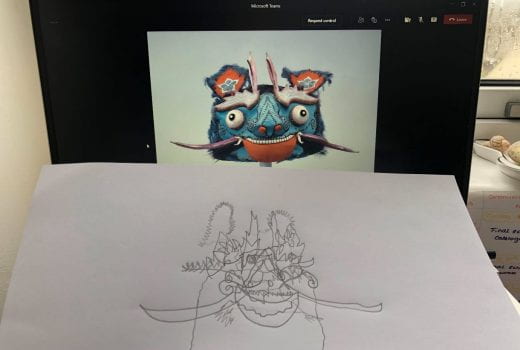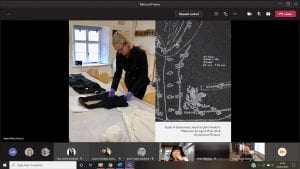
Rachel Ng, Third Year BA (Hons) Fashion and Dress History student discusses her experience of attending a workshop with Dr Ingrid Mida on observing a garment through drawing.
Author of The Dress Detective and Reading Fashion in Art Dr Ingrid Mida recently hosted a drawing workshop online via MS Teams. Her ‘Slow Approach to Seeing’ methodology demonstrates how to analyse a garment, focusing on slowing down and using drawing as a tool for learning. In her 2020 book Reading Fashion in Art, Mida states that ‘[…] drawing as a method of slowing down can help identify specific elements of dress as well as the nuances of an artist’s process’. (42) The workshop allowed us to understand the difference between looking and seeing and how one can look but not really see.
Mida describes: ‘For me, drawing facilitates seeing and a deeper level of engagement with a thing. I record the path of my eyes on the paper as I study the object or artwork, and even if my drawing bares little or no resemblance to the thing I am looking at, when I finish a drawing, I feel like I have touched that thing’. (2020: 42) To fully understand this process, we were asked to complete three short drawing exercises to warm-up for a larger drawing piece later. The short tasks allowed us to break down any expectations we may have had about the ways in which our drawings may have looked. Instead, we were encouraged to focus on the process over product. We were drawing a Chinese dragon hat. We started by using two pencils in one hand, focusing on the aerial view of the hat. Then we were asked to draw with our non-dominate hand, focusing on the side view. Lastly, we looked at the front view, drawing in one continuous line without glancing at the paper. As you can see in Figure 2, my drawing did not look too much like the hat, but then again it wasn’t supposed to. For our final longer task, we drew a jacket and then had a discussion which revealed the details people picked up on, that might have been otherwise overlooked. For example, the piece’s overall construction, hidden buttonholes, and the lack of pattern matching. This process has allowed me to think differently about the next time I view a garment and how drawing can really help to highlight the details that may point to the wearer’s intentions, such as the points of stress on a piece.

Figure 2: Side-by-Side Comparison of a Continuous Line Drawing with Object, 2021. Pencil on Paper. Photograph. Author’s Own Image.
Due to the pandemic so much of our lives now inhabit the internet and screen time. People’s attention span has dropped, and this workshop has reminded me of how much you can easily miss when you do not slow down and really focus on something. This method can, of course, be challenging for people who have expectations of how they want a drawing to turn out, but as Mida said in her talk, you have to let go of expectations and return to a childlike mind to fully appreciate this method of research. What resonated most with me was her closing statement, ‘wanting to discover the information has to be more important than the drawing’.
It was great to be able to put a face to the well-renowned author and gain a better understanding of how to break down and construct garment drawings. I thoroughly enjoyed the experience and will be using this approach in the future.


It was such a pleasure to run this drawing workshop and share this method of seeing. Thank you Rachel for your thoughtful reflection. I hope you and other students will continue to use this method of drawing to look longer and see more!